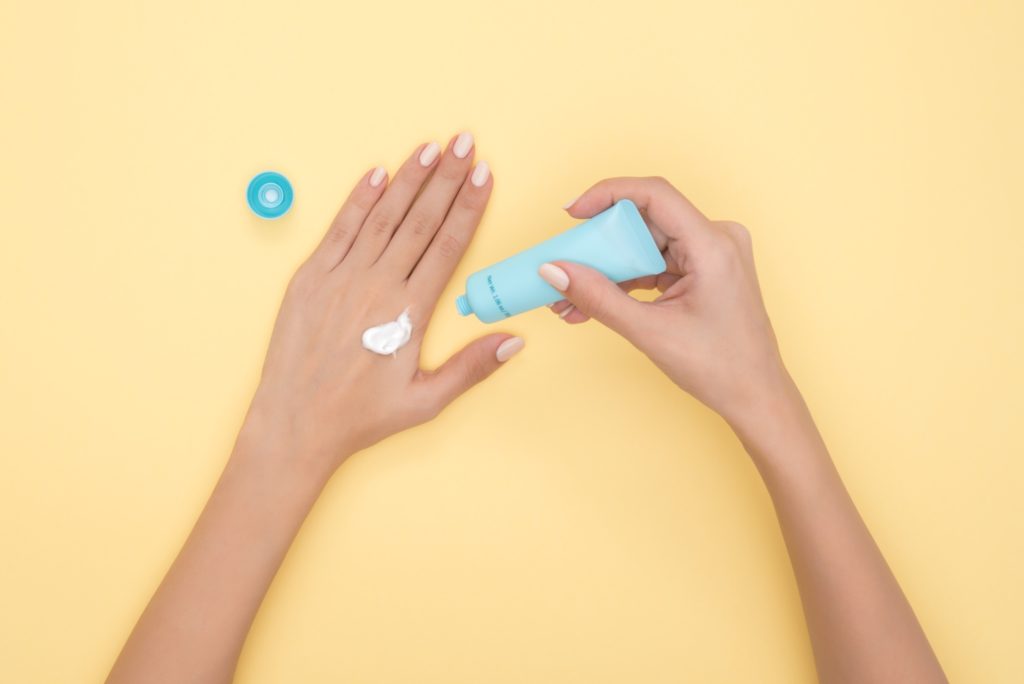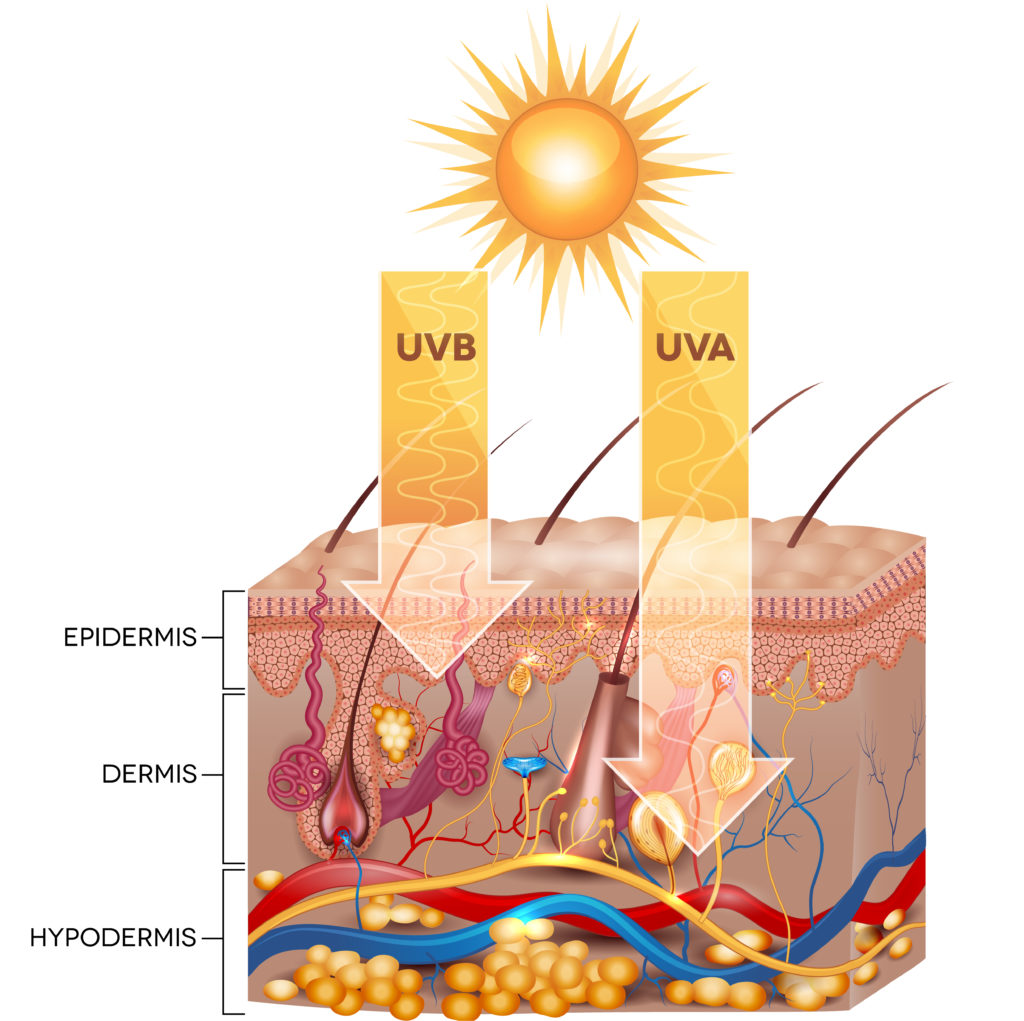Sunscreen is a product many of us use, some even daily in our cosmetics and not just when we head for the beach. You may have heard, in recent years, of sunscreens’ negative effect on coral reef habitats, which not only affects the reef itself but also the species that live within it. Beaches with coral reef habitats have begun to ban the use of sunscreens that contain harmful chemicals. These chemicals not only affect wildlife but also human beings.
Sunscreen is still very beneficial, but it is important to be aware of what you are buying and select a sunscreen that both protects the skin and does not harm the body or the planet. To learn more about the benefits of sun exposure on the skin, check out our article on the Risks and Benefits of Sun Exposure.
Conventional sunscreen contains between two to eight UV filters. They often contain multiple phenols, such as azobenzene, benzophenone -3, and parabens. Zinc oxide and titanium dioxide, which act in sunscreen as nanoparticle UV filters, are also very common (Wolff, M.S., et al., 2017).

What is SPF – Sun Protective Factor
Many people are mistaken about the meaning of SPF. Sun Protective Factor, and its varying numbers, is not an indication of how long you are protected from UV rays (eg; SPF 15 = 15 minutes). Instead, it is an indication of how many harmful rays are mitigated from being absorbed and potentially contributing to erythema (sunburn).
SPF 15, for instance, provides protection against 14 of 15 harmful UV rays or it lets in 1 in 15 rays to the skin, protecting about 93%. SPF 30 will allow in 1 of every 30 harmful UV rays, protecting 97%. SPF 50 will allow 1 in every 50 harmful UV rays, providing protection of about 98% for the skin. There isn’t much of a difference in how much protection you get from sunscreen, for instance comparing SPF 30 to SPF 50. Some researchers even find that if applied properly, SPF 15 would be sufficient (Diffey, B., 1999).
The issue with sunscreen lies in its application and reapplication. Sunscreen lotions and sprays will provide directions for use. Just as you would follow the instructions for using a medication, so should you for using sunscreen. There is an amount that needs to be applied to provide ample protection, this amount will differ from product to product. There will also be a set time for reapplication. During sunscreen efficacy testing the most common issue when sunscreen is used and erythema or a sunburn develops is an inconsistency in application and a lack of reapplication (Paul, S.P., 2019).

UV Filters Impact on Hormonal and Reproductive Health
Increasingly organic UV filters (chemical filters) are endocrine disruptors. They easily absorb into the skin and bioaccumulate in tissue (due to their persistence, stability, and being lipophilic). The issue of their accumulation would not be so bad if they were not present in countless other products that we use or are exposed to daily (Krause, M., et al., 2012).
They are increasingly found in our environment with samples being taken from wastewater treatment plants, fish and seaweed, breast milk, and placenta(Wang, J., et al., 2016).
A 2018 study that looked on the effect of sunscreen on sperm function found that 13 of 29 common UV filters tested, negatively affect male fertility. A few UV filters are endocrine disruptors, which mimic the function of progesterone affecting the intracellular Ca2+ receptor in sperm cells which must be turned on at the right time and in the right order to enable fertilization (Rehfeld, A., et al., 2018).
A 2010 study found that 85.2% of breast milk tested over a three year period contained chemical UV filters within the samples. The chemicals included 4-methyl benzylidene and octocrylene. The presence is strongly correlated to sunscreen and cosmetic use (Schlumpft, M., et al., 2010).
A 2019 randomized clinical trial found that the absorption of sunscreen’s active ingredients, the ones that prevent UV radiation from affecting the skin such as oxybenzone, octocrylene, and ecamsule, was far over the recommended safe daily limit. In the study, participants applied sunscreen four times a day, consistent with an amount an individual at the beach would apply, particularly if they are fair-skinned (Matta, M.K., et al., 2019).
Organic UV filters
There are three types of UV filters; organic (chemical), inorganic (mineral/physical), and insoluble organic pigments. There is a heightened concern over organic UV filter and their effect on human and environmental health and well being. They are easily absorbed by the skin, and although they are metabolized and excreted, they do bioaccumulate in the body as they are lipophilic, this can lead to internal toxicity (Yazar, S., et al., 2018).
Benzophenones
Commonly used in sunscreen as well as in cosmetics and skincare products. It has been found in wastewater, urine samples, and breast milk. Benzophenone is known to imbalance estrogen and androgen levels in the body, as well as affecting normal testosterone levels in a male mice study. Though more research needs to be conducted it may affect the thyroid (Paul, S.P., 2019).
Oxybenzone
Oxybenzone used in sunscreens to minimize the effect of UVA and UVB radiation on the skin. It is an environmental and human toxin. The Center for Disease Control tested for the prevalence of chemical residue in urine, oxybenzone was found in 97% of participants’ urine samples. It has also entered into the water system affecting marine life, coral reefs, and drinking water (DiNardo, J.C., et al., 2018).
Oxybenzone is an endocrine disruptor and has been linked to Hirschsprung’s disease. It has also been shown to have a negative reaction with chlorine, which is present in most drinking water and chlorinated pools (DiNardo, J.C., et al., 2018).

Avobenzone
Avobenzone is a widely used UV filter and product stabilizer. It has been shown to form byproducts when exposed to fresh, salt, or chlorinated water (Lebeden, A.T., et al., 2020). Unfortunately, when exposed to sunlight it releases free radicals which result in oxidative stress and damage to skin cells, potentially contributing the cancer development (Kavitha, J., et al., 2016). Some sunscreens may add in antioxidants to combat the resulting free radical damage, which may aid in mitigation. The use of antioxidants in sunscreen does have a positive effect on reducing inflammation caused by UV rays. Avobenzone, as with oxybenzone have reported issues with negatively affecting fertility and contributing to birth defects (Kavitha, J., et al., 2016).
Camphor
A UV absorber commonly used in sunscreen products and cosmetics. It is a lipophilic organic compound that bioaccumulates in the tissues. It has displayed anti-estrogen and pro-progesterone activities within fish, animals, and cell-based tests (Paul, S.P., 2019).
Homosalate
This sunscreen additive acts as an endocrine active substance. When more than one product that contains homosalate is used, its accumulation has been linked to increased sensitivity, contributing to hormonal imbalance (affecting estrogen, androgen, and progesterone), and has been shown to increase the absorption of pesticides into the body. The FDA limit of homosalate is 15% of the total product (eg; sunscreen), anymore and it is too much for the body. With it also being found in skincare products and cosmetics, it is very likely that the skin will absorb too much (Imamovic, B., et al., 2017).
Retinyl Palmitate
This form of vitamin A commonly used in sunscreens has been shown to elevate the risk of contracting skin tumors and lesions (Latha, M.S., et al., 2013) (Paul, S.P., 2019).
Phthalate
Phthalates are known endocrine disruptors (Ferguson, K.K., et al., 2017). Found in sunscreen (as well as mouthwash, household cleaning products, plastics, high-fat milk from intensive livestock operations, and tin cans) they absorb easily through the skin and are found in high concentrations in urine (Ferguson, K.K., et al., 2017) (Sugeng, E.J., et al., 2020).
Pregnant women exposed to phthalates can negatively affect offspring in the womb and those breastfeeding. Side effects include obesity, neurodevelopment problems, and allergies (Sugeng, E.J., et al., 2020) (Polinski, K.J., et al., 2018) (Wolff, M.S., et al., 2017). A 2019 Canadian study looked at phthalate content present in infant urine samples. Infants ranging in age from 3, 12, and 36 months had urine samples tested for 8 phthalates. Phthalates were present amongst more urine samples, interesting enough they were decisively higher when the temperature outdoors was very warm (Navaranjan, G., et al., 2019). Though it is more than sunscreen that adds to phthalate content in the body, it is important to reduce its presence in the body as much as possible, after all, they are endocrine disruptors.
Inorganic UV Filters – Mineral Filters
Mineral UV filters are the only filters in sunscreen that are accepted ingredients to be labeled as bio or natural, as they are considered to be safe for both consumers and the environment. In recent years mineral formulas have moved into nanoparticles due to their transparency on the skin’s surface. Studies that look into their health and environmental impacts are mixed as their processing in sunscreen formulas and other cosmetic products (where they are used as stabilizers for fragrance and color (Bilal, M., et al., 2020)) is vastly different. Their size, what they are coated with, and how many times they are coated all play a factor in how they may affect the body and surrounding ecosystem.
Mineral filters need to be coated to prevent photocatalytic reactions and dispersion in sunscreen formulas. They often contain both an internal and external layer (Catalano, R., et al., 2020). Titanium dioxide nanoparticles, for example, are often coated with an aluminum layer to prevent any harmful effects from forming due to hydroxyl radicals, superoxide anions, and other reactive oxygen species. These occur when titanium dioxide is exposed to UV radiation. The aluminum coating prevents this from occurring. But is aluminum always stable? Supposedly not in a chlorinated pool. Chlorine concentrations the reach levels of between 0.2ppm to 7ppm can make aluminum unstable, leading to a loss of its protective ability for containing titanium dioxide (Virkutyte, J., et al., 2012).
How many of us apply sunscreen at an outdoor pool? It is crucial to read ingredient labels on sunscreen. A 2007 study that looked into titanium-based sunscreens, found that aluminum was present in all products they tested. However, aluminum was only labeled as an ingredient in three of seven sunscreens tested. Furthermore, to prevent titanium agglomeration a lot of aluminum is used as a coating. A single application of sunscreen containing aluminum may provide upwards of 200 mg of Al. Reapplication, which is necessary especially when spending the whole day outside can potentially result in a gram of aluminum being applied to the skin’s surface (Nicholson, S., et al., 2007).
Although they aid in protecting the skin from UV damage, skin that is damaged increases the absorption of both titanium dioxide and zinc oxide. Studies showing that they enter even further into the skin, being absorbed deeper than the transdermal layer (Monterio-Riviere, N.A., et al., 2011). Nanoparticles from sunscreen have displayed toxicity towards urchins, algae, protozoa, and other marine species. This may be due to oxidative damage and an increase in reactive oxygen species (Bilal, M., et al., 2020).
Antioxidants in Sunscreen
When the SPF of sunscreen is tested, what is looked at is its ability to inhibit the development of erythema or sunburns. Researchers have differing views on the addition of anti-inflammatory/antioxidant compounds into sunscreens, specifically that they increase the products SPF. Some research has shown that the addition of anti-inflammatory and antioxidant compounds inhibits sunburns from developing and gives the product a higher SPF. While other studies have found that the addition of anti-inflammatory and antioxidant compounds does not influence SPF values. The main reason they give for the sunscreen not working as effectively for consumers is the misuse of the product (Kolbe, L., et al., 2019).
When a sunburn occurs it creates free radicals, which can lead to oxidative damage on and in the skin. Anti-inflammatory and antioxidant compounds eliminate free radical damage, thus preventing sunburns from occurring. Furthermore, inflammation also plays a role in photodamage/skin cancer development and growth, the addition of anti-inflammatory, as well as antioxidant compounds, can be very beneficial (Chen, L., et al., 2012) (Kolbe, L., et al., 2019).

Sunscreens Negative Effects on Coral Reef
Coral reef ecosystems are ecologically and economically important for coastal destinations globally as they are a part of tourism and recreation. But as such destinations have become more popular over the past few decades, so has the increase in sunscreen usage on coastlines nearby coral reefs.
Sunscreen, which as we know reduces exposure to UVA and UVB rays, washes off the body in water (sometimes you will even see pools of oil around your skin as you submerge your sunscreen coated body into the water) which overtime negatively affects the surrounding aquatic ecosystem. Between 6000 – 14000 tons of sunscreen lotion is released into coral reef ecosystems annually, resulting in 10% of coral reefs to be exposed to harmful chemicals (Catalano, R., et al., 2020).
The most dramatic display of the negative side of sunscreen in the environment is the bleaching of the coral reef. This occurs as a result of an inability to photosynthesize, which is the responsibility of tiny algae, known as zooxanthellae, that live among healthy coral. Hawaii prohibits the sale and use of sunscreens that contain oxybenzone and octinoxate (a law that will go into effect on Jan. 1, 2021). Other beach destinations have followed suit such as the US Virgin Islands, Bonaire Island, and countries Palau and Aruba.
Sunscreen not only negatively affected coral reef but also the species that live within it. Studies that looked into the effects of sunscreen on flatworms, symbiotic algae, diatoms, aiptasia, and coral found that all species were negatively affected by sunscreen exposure. Flatworms that were exposed to sunscreen preferred darker conditions, which in their natural ecosystem could make it harder for them to survive (McCoshum, S.M., et al., 2016).
References
Bilal, M., Mehmood, S., Lqbal, H.M.N. (2020). The Beast of Beauty: Environmental and Health Concerns of Toxic Components in Cosmetics. Cosmetics. Volume 7, Issue 1, pages 13.
Catalano, R., Masion, A., Ziarelli, F., Slomberg, D., Laisney, J., Unrine, J.M., Campos, A., Labille, J. (2020). Optimizing the dispersion of nanoparticulate TiO2 – based UV filters in a non-polar-medium used in sunscreen formulations – The role of surfactants and particle coatings. Colloids and Surfaces A.
Chen, L., Hu, J.Y., Wang, S.Q. (2012). The Role of Antioxidants in Photoprotection. A critical review. Dermatology. Volume 67, Issue 5, pages 1013-1024.
Differy, B. (1999). Has the sun protection factor had its day? The British Medical Journal. Volume 2000, Issue 320, page 176.
DiNardo, J.C., Downs. C.A. (2018). Dermatological and environmental toxicological impact of the sunscreen ingredient oxybenzone/benzophenone-3. Journal of Cosmetic Dermatology. Volume 17, Issue 1. pages 15-19.
Ferguson, K.K., Colancino, J.A., Lewis, R.C., Meeker, J.D. (2017). Personal Care Products use among adults in NHANES: associations between urinary phthalate metabolites and phenols and use of mouthwash and sunscreen. Journal of Exposure Science and Environmental Epidemiology. Volume 27, pages 326-332.
Imamovic, B., Besic, Z., Becic, E. (2017). A novel and widely accessible HPLC Method for determination content of homosalate in sunscreen products on the market. Journal of Health and Science. Volume 7, Issue 3.
Kavitha, J., Lakshmi, K.S. (2016). Design of Experiments Based Validated HPTLC Method for Quantification of Oxybenzone and Avobenzone in Personal Care Products. Eurasian Journal of Analytical Chemistry. Volume 12, Issue 4, pages 417-428.
Krause, M., Jensen, M.B., Klit, A., Soeborg, T., Frederiksen, H., Schlumpf, M., Lichtensteiger, W., Skakkebek, N.E., Drzewiecki, K.T. (2012). Sunscreens: Are They Beneficial for Health? An Overview of Endocrine Disrupting properties of UV-filters. International Journal of Andrology. Volume 35, Issue 3, pages 424-36.
Kolbe, L., Pissavini, M., Tricaud, C., Trullas, Cabanas, C., Dietrich, E., Matts, P.J. (2019). Anti-inflammatory/Antioxidant Activity of ingredients of sunscreen product? Implications for SPF. International Journal of Cosmetic Science. Volume 41, Issue 3, pages 320-324.
Latha, M. S., Martis, J., Shobha, V., Sham Shinde, R., Bangera, S., Krishnankutty, B., … Naveen Kumar, B. R. (2013). Sunscreening agents: a review. The Journal of clinical and aesthetic dermatology, 6(1), 16–26.
Lebedev, A.T., Kralj, M.B., Polyakova, O.L., Detenchuk, E.A., Pokryshkin, S.A., Trebse, P. (2020). Identification of avobenzone by-products formed by various disinfectants in different types of swimming pool waters. Environment International. Volume 137.
Matta MK, Zusterzeel R, Pilli NR, et al. Effect of Sunscreen Application Under Maximal Use Conditions on Plasma Concentration of Sunscreen Active Ingredients: A Randomized Clinical Trial. JAMA. Published online May 06, 2019321(21):2082–2091.
McCoshum, S.M., Schlarb, A.M., Baum, K.A. (2016). Direct and Indirect Effects of Sunscreen exposure for reef biota. Hydrobiologia. 776, pages 139-146.
Monterio-Riviere, N.A., Wiench, K., Landsiedel, R., Schulte, S., Inman, A.O., Rivire, J.E. (2011). Safety Evaluation of Sunscreen Formulations Containing Titanium Dioxide and Zinc Oxide Nanoparticles in UVB Sunburned Skin: An in Vitro and in Vivo Study. Toxicology Sciences. Volume 123, Issue 1, pages 264-280.
Navaranjan, G., Takaro, T.K., Wheeler, A.J., Diamond, M.L., Shu, H., Azad, M.B., Becker, A.B., Dai, R., Harris, S., Lefebure, D.L., Lu, Z., Mandhane, P.J., McLean, K., Sears, M.R., Subbarao, P., Brook, J.R. (2019). Early Life Exposure to phthalates in Canadian Healthy Infant Longitudinal Development (CHILD) study: A multi-city birth cohort. Journal of Exposure Science and Environmental Epidemiology. Volume 30, pages 70-85.
Nicholson, S., Exley, C. (2007). Aluminum: A potential pro-oxidant in sunscreens/sunblocks? Free Radical Biology and Medicine. Volume 43, Issue 8, pages 1216-1217.
Paul, S.P. (2019). Ensuring the Safety of Sunscreens, and their efficacy in preventing skin Cancers: Challenges and controversies for clinicians, formulations and regulators. Frontiers of Medicine. Volume 6, pages 195.
Polinski, K.J., Debelea, D., Hamman, R.F., Adgate, J.L., Calafat, A.M., Ye, X., Starling, A.P. (2018). Distribution and predictors of urinary concentrations of phthalate metabolites and phenols among pregnant women in the Healthy Start Study. Environmental Research. Volume 162, pages 308-317.
Rehfeld, A., Egeberg, D. L., Almstrup, K., Petersen, J. H., Dissing, S., & Skakkebæk, N. E. (2018). EDC IMPACT: Chemical UV filters can affect human sperm function in a progesterone-like manner. Endocrine connections, 7(1), 16–25.
Schlumpf, M., Kypke, K., Wittassek, M., Angerer, J., Mascher, H., Mascher, D., Vokt, C., Birchler, M., Lichtensteiger, W. (2010). Exposure patterns of UV filters, fragrances, parabens, phthalates, organochlor pesticides, PBDEs, and PCBs in milk: correlation of UV filters with use of cosmetics. Chemosphere. Volume 81, Issue 10, pages 1171-1183.
Sugeng, E.J., Symeonides, C., O’Hely, M., Vuillermin, P., Sly, P.D., Vijayasarathy, S., Ponsonby, A-L., The Barwon Infant Study Investigation Group. (2020). Predictors with regards to ingestion, inhalation and dermal absorption of estimated phthalate daily intake in pregnant women: The Barwon Infant Study. Environment International. Volume 139.
Tibbetts J. (2008). Bleached, but not by the sun: sunscreen linked to coral damage. Environmental health perspectives, 116(4), A173.
Virkutyte, J., Al-Abed, S.R., Dionysiou, D.D. (2012). Depletion of the protective aluminum hydroxide coating in Ti02-based sunscreen by swimming pool water ingredients. Chemical Engineering Journal. Volume 191, pages 95-103.
Wang, J., Pan, L., Wu, S., Lu, L., Xu, Y., Zhu, Y., Guo, M., Zhuang, S. (2016). Recent Advances on Endocrine Disrupting Effect of UV filters. International Journal of Environmental Research and Public Health. Volume 13, Issue 8, Pages 782.
Wolff, M.S., Buckley, J., Engel, S.M., McLonnell, R.S., Barr, D.B. (2017). Emerging Exposures of Developmental Toxicants. Opinion in Pediatrics. Volume 29, Issue 2, Pages 218-224.
Yazar, S. Gokçek, Y. (2018). Assessment of in vitro genotoxicity effect of homosalate in cosmetics. Marmara Pharmaceutical Journal. Volume 22, Issue 3, pages 436-442.
Amanda Filipowicz is a certified nutritional practitioner (CNP) with a bachelor in environmental studies (BES) from York University. She also has certification in clinical detoxification, prenatal and postnatal care as well as nutrition for mental health. She has been working as a nutritionist since 2013 and is a lifelong proponent of eating healthy.

